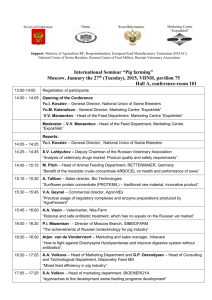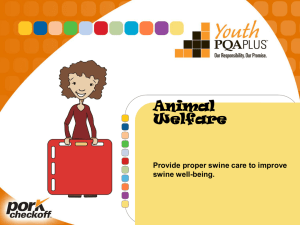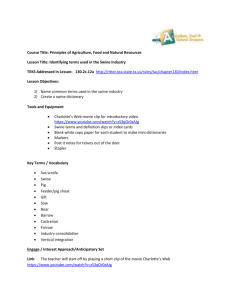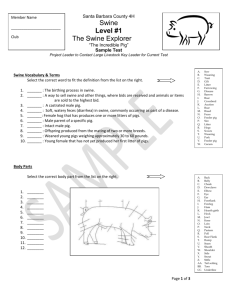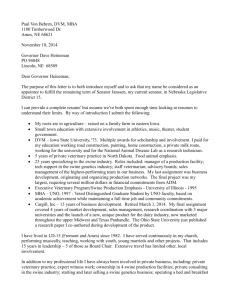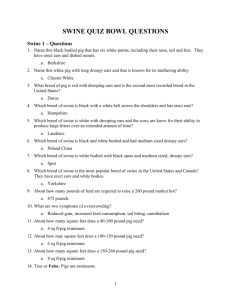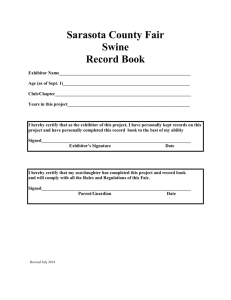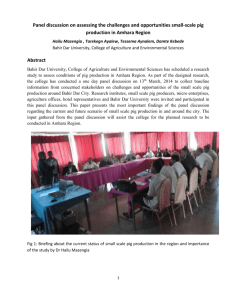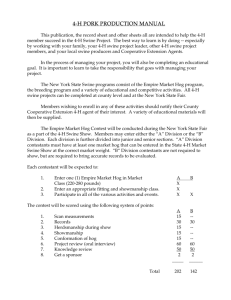Tasks - University of Missouri - College of Veterinary Medicine
advertisement
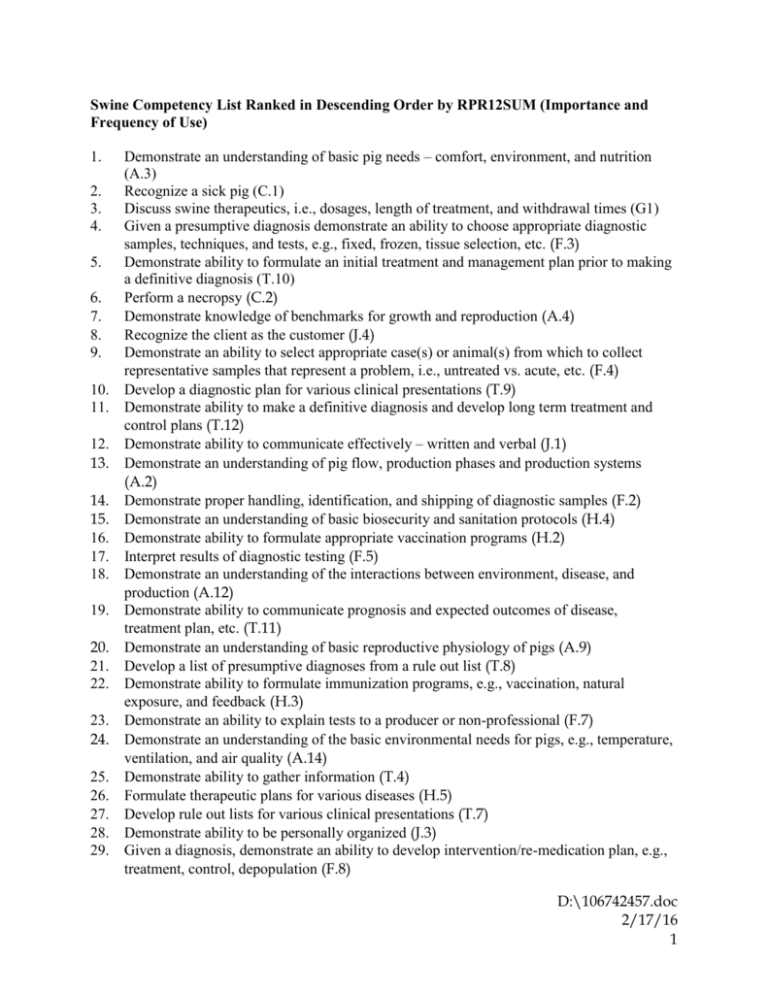
Swine Competency List Ranked in Descending Order by RPR12SUM (Importance and Frequency of Use) 1. 2. 3. 4. 5. 6. 7. 8. 9. 10. 11. 12. 13. 14. 15. 16. 17. 18. 19. 20. 21. 22. 23. 24. 25. 26. 27. 28. 29. Demonstrate an understanding of basic pig needs – comfort, environment, and nutrition (A.3) Recognize a sick pig (C.1) Discuss swine therapeutics, i.e., dosages, length of treatment, and withdrawal times (G1) Given a presumptive diagnosis demonstrate an ability to choose appropriate diagnostic samples, techniques, and tests, e.g., fixed, frozen, tissue selection, etc. (F.3) Demonstrate ability to formulate an initial treatment and management plan prior to making a definitive diagnosis (T.10) Perform a necropsy (C.2) Demonstrate knowledge of benchmarks for growth and reproduction (A.4) Recognize the client as the customer (J.4) Demonstrate an ability to select appropriate case(s) or animal(s) from which to collect representative samples that represent a problem, i.e., untreated vs. acute, etc. (F.4) Develop a diagnostic plan for various clinical presentations (T.9) Demonstrate ability to make a definitive diagnosis and develop long term treatment and control plans (T.12) Demonstrate ability to communicate effectively – written and verbal (J.1) Demonstrate an understanding of pig flow, production phases and production systems (A.2) Demonstrate proper handling, identification, and shipping of diagnostic samples (F.2) Demonstrate an understanding of basic biosecurity and sanitation protocols (H.4) Demonstrate ability to formulate appropriate vaccination programs (H.2) Interpret results of diagnostic testing (F.5) Demonstrate an understanding of the interactions between environment, disease, and production (A.12) Demonstrate ability to communicate prognosis and expected outcomes of disease, treatment plan, etc. (T.11) Demonstrate an understanding of basic reproductive physiology of pigs (A.9) Develop a list of presumptive diagnoses from a rule out list (T.8) Demonstrate ability to formulate immunization programs, e.g., vaccination, natural exposure, and feedback (H.3) Demonstrate an ability to explain tests to a producer or non-professional (F.7) Demonstrate an understanding of the basic environmental needs for pigs, e.g., temperature, ventilation, and air quality (A.14) Demonstrate ability to gather information (T.4) Formulate therapeutic plans for various diseases (H.5) Develop rule out lists for various clinical presentations (T.7) Demonstrate ability to be personally organized (J.3) Given a diagnosis, demonstrate an ability to develop intervention/re-medication plan, e.g., treatment, control, depopulation (F.8) D:\106742457.doc 2/17/16 1 30. 31. 32. 33. 34. 35. 36. 37. 38. 39. 40. 41. 42. 43. 44. 45. 46. 47. 48. 49. 50. 51. 52. 53. 54. 55. 56. 57. 58. 59. Exhibit good listening & observational skills, recognize verbal & non-verbal signals (J.2) Demonstrate ability to bleed swine of various ages (C.7) Demonstrate ability to work with teams, e.g., farm, practice, industry, colleagues (J.5) Demonstrate ability to evaluate a pen, i.e., feeders, waterers, environment, and pig comfort (A.15) Explain the influence of pig flow on disease, e.g., all in – all out (AIAO) and segregated early weaning (SEW), (H.1) Calculate inclusion rates of feed and water medications consistent with therapeutic objectives (G.9) Demonstrate an understanding of the dynamic nature of disease within a herd and of appropriately adjusting treatment/management plans (T.13) Demonstrate an understanding of the strategies and objectives of drug use, e.g., continuous, growth, treatment, and pulse (G.6) Demonstrate an ability to access, manipulate, present and use electronic information, i.e., WWW, spreadsheets, word processing, databases, and digital imaging (K.1) Identify and discuss contributing risk factors, e.g., environment, pig flow, nutrition, genetics, etc. (T.6) Demonstrate proper handling and/or understanding of injection sites (F.1e.) Demonstrate proper handling and/or understanding of water medication (F.1c.) Demonstrate proper handling and/or understanding of feed medication (F.1d.) Discuss individual animal treatment economics (C.5) Demonstrate an understanding of cost vs. benefit of inputs (R.2) Discuss how to manage risk factors that contribute to clinical expression of different clinical or management problems (H.6) Demonstrate an understanding of the cost components of producing pigs (R.1) Develop compliance strategies for drug withdrawals (G.5) With information from clinical examinations develop a problem list for each one of several disease scenarios (T.5) Explain the regulatory impact of Valid veterinary-client-patient relationship (VCPR) (S.2b.) Discuss the impact of medication usage on residues, withdrawal times, broken needles, and iatrogenic defects (L.3) Demonstrate ability to use production records to develop a diagnostic plan (B.2) Explain the importance of medical/laboratory records and demonstrate ability to maintain appropriate records (F.6) Demonstrate an understanding of reproduction management (A.16) Demonstrate proper handling and/or understanding of needles (F.1b.) Demonstrate knowledge of Pork Quality Assurance (PQA) programs (L.1) Explain the regulatory impact of Explain the regulatory impact of Extra label use of drugs (ELUD), (S.2c.) Demonstrate an understanding of basic pig behavior (A.6) Identify production problems from records or spreadsheets (B.1) Understand the importance of sample size for diagnosis and surveillance (B.3) D:\106742457.doc 2/17/16 2 60. 61. 62. 63. 64. 65. 66. 67. 68. 69. 70. 71. 72. 73. 74. 75. 76. 77. 78. 79. 80. 81. 82. 83. 84. 85. 86. 87. 88. 89. 90. 91. 92. 93. 94. 95. Explain the benefits derived from pursuing continuing education (M.3) Demonstrate proper handling and/or understanding of syringes (F.1a.) Demonstrate ability to discriminate between important and “garbage” data (B.7) Perform a physical examination (C.3) Evaluate sow flow/movement through reproductive cycle (A.16c.) Demonstrate an understanding of diagnostic tests, i.e., sensitivity, specificity and error (laboratory, collection, etc.), (B.12) Demonstrate an understanding of supportive care “TLC” (C.6) Demonstrate an understanding of basic pig nutritional requirements (P.1) Demonstrate ability to detect estrus in sows (A.16f.) Explain the regulatory impact of prescription writing (non-feed administration), (S.2e.) Demonstrate an understanding of and discuss the benefits of adherence to the veterinarian’s oath (M.1) Define a complaint (T.2) Demonstrate an understanding of the biology of growth in pigs (A.10) Discuss the moral and legal obligations of complying with regulations (M.5) Demonstrate an understanding of basic standards of pig welfare, e.g., National Pork Producers Council Guide (C.8) Demonstrate an understanding of how and when to perform euthanasia (D.5) Demonstrate knowledge of normal parturition and dystocia (A.16b.) Explain life cycle feeding of breeding animals (P.10) Demonstrate ability to critically review literature (B.10) Describe your role and responsibility as an accredited veterinarian (Q.1) Describe signalment and explain its importance (T.1) Recognize potential conflicts of interest that may occur in practice and discuss methods to minimize them (M.4) Demonstrate ability to diagnose pregnancy (A.16g.) Explain with understanding the importance of networking among colleagues (O.3) Demonstrate ability to treat an individual pig (C.4) Describe the swine disease control/eradication programs currently in force (Q.3) Describe problems related to feed particle size and develop plans for correction (P.8) Explain the regulatory impact of Veterinary Feed Directive (VFD), (S.2d.) Explain the role of production practices on food safety of the end product (N.1) Describe how pre- and post-harvest management factors relate to food safety (N.2) Given various complaints, assemble a history for each complaint (T.3) Explain farm level data recording (A.13) Demonstrate an understanding of financial terminology (R.6) Demonstrate pig-handling skills, e.g., flight zone, etc. (A.7) Explain the principles of antimicrobial resistance (G.8) Demonstrate an understanding of drug interactions and incompatibilities in both delivery systems and the animal, e.g., solubility, stability, and palatability (G.3) D:\106742457.doc 2/17/16 3 96. 97. 98. 99. 100. 101. 102. 103. 104. 105. 106. 107. 108. 109. 110. 111. 112. 113. 114. 115. 116. 117. 118. 119. 120. 121. 122. 123. 124. List the available euthanasia techniques, e.g., American Association of Swine Practitioners Guide (D.3) Demonstrate ability to properly sample feed and water for nutrient and toxins analysis (P.3) Demonstrate an understanding of swine market markets (R.8) Explain the regulatory impact of Animal Medicinal Drug Use Clarification Act (AMDUCA), (S.2a.) Discuss the risk factors and control measures related to diseases that are transmitted between swine and humans (N.3) Summarize how and why a swine practitioner should be an advocate of the swine industry (O.2) Demonstrate ability to estimate body weight and body condition (A.5) List and describe the issues related to human health hazards in swine production (N.5) Demonstrate skills related to personal financial management (I.1) Demonstrate ability to describe and present data appropriately, i.e., descriptive statistics (B.6) Demonstrate an ability to use Compendium of Veterinary Products as a resource (S.1b.) Demonstrate an ability to use Feed Additive Compendium as a resource (S.1a) Explain the advantages of seeking a second opinion and discuss the reasons a practitioner may fail to do so (M.2) Recognize signs of nutrient deficiencies, e.g., Vitamins, E/Se, Zn, and Fe (P.6a.) Demonstrate an understanding of how to perform a castration (E.2g.) Demonstrate ability to mate female, i.e. artificial insemination, hand mate (A.16a.) Calculate appropriate sample size from tables and explain their use (B.4) Demonstrate ability to interpret nutrient analysis of feed (P.4) Evaluate potential employer for match with personal, financial, and professional goals (I.10) Demonstrate piglet processing skills, i.e., tail docking, castration, iron injections, clip needle teeth, etc. (A.11) Explain why swine practitioners should play an active role in public health issues (N.4) Develop a partial budget (R.5) Develop a personal practice budget, i.e., dollars needed to support salary and practice overhead (I.2) Explain sampling strategies, e.g., random, stratified, and representative (B.5) Demonstrate an understanding of the principles of quality assurance programs, e.g., Hazard Analysis and Critical Control Point (HACCP), Good Manufacturing Procedures (GMP), ISO 9000, Environmental Quality Assurance, etc. (L.2) Demonstrate an understanding of risk management, i.e., production risk, market risk, and financial risk (R.4) Demonstrate an understanding of how to perform an inguinal hernia repair (E.2h.) Discuss issues related to compounding drugs (G.4) Demonstrate ability to cross check diet budgets (P.7) D:\106742457.doc 2/17/16 4 125. Recognize potential applications of non-antimicrobial growth-enhancing feed and water additives, e.g., Zn oxide, water acidifiers, etc. (P.11) 126. Recognize signs of nutrient toxicities, e.g., Se, As, Na, Vitamin D, and Cu (P.6b.) 127. Discuss the biological plausibility of economic projections (R.7) 128. List the elements of a field investigation (B.9) 129. Demonstrate an understanding of how to a vasectomy (E.2b.) 130. Demonstrate an understanding of how to perform rectal, vaginal, and uterine prolapse repair (E.2f.) 131. Perform semen evaluation (A.16e.) 132. Discuss the veterinarian’s role in the broader community (M.6) 133. Demonstrate an understanding of drug toxicities (G.7) 134. Demonstrate an understanding of staffing and personnel needs in various pig production facilities, e.g., human/pig ratio (A.8) 135. Demonstrate an ability to use Food Animal Residue Avoidance Databank (FARAD) as a resource (S.1d.) 136. Demonstrate an understanding of financing (I.3d.) 137. Demonstrate an understanding of lean growth curves - relationship between nutrition and growth (P.9) 138. Demonstrate an understanding of field operative procedures – restraint, anesthesia, sanitary techniques, and post-operative care (E.3) 139. Demonstrate an understanding of the differences between enterprise and partial budgets and when their use is applicable (R.3) 140. Explain the benefits of participating in organized veterinary medicine (O.1) 141. Demonstrate ability to interpret analysis of water (P.5) 142. Demonstrate an understanding of budgeting (I.3c.) 143. Demonstrate knowledge of semen collection from a boar (A.16d.) 144. Demonstrate an understanding of return investment (I.9d.) 145. Demonstrate an ability to use Veterinary Pharmaceuticals and Biologicals (VPB) as a resource (S.1c.) 146. Describe the role of a veterinarian in human resources (personnel) management (I.4) 147. Explain the principles of pharmacokinetics (G.2) 148. Demonstrate an understanding of an income statement (I.3a.) 149. Demonstrate an ability to formulate an appropriate diet to meet the requirements of different classes of swine (P.2) 150. Summarize the principles of hypothesis testing (B.8) 151. Demonstrate an understanding of a balance sheet (I.3b.) 152. Demonstrate an understanding of the time-value of money (I.9c.) 153. Demonstrate basic study design skills, i.e., retrospective vs. prospective vs. clinical trials (B.11) 154. Identify breeds of swine (A.1) 155. List and describe the role and scope of agencies which regulate the livestock industry, i.e., Department of Natural Resources (DNR), Environmental Protection Agency (EPA), Food and Drug Administration (FDA), etc. (Q.2) D:\106742457.doc 2/17/16 5 156. 157. 158. 159. 160. 161. 162. 163. 164. 165. 166. 167. 168. 169. 170. 171. 172. 173. 174. 175. 176. 177. Demonstrate an understanding of asset management (I.9a.) Demonstrate an understanding of depreciation (I.9e.) Discuss employee evaluation and the relationship of an evaluation to a job description (I.7) Demonstrate an understanding of the financial topic, goodwill (I.9f.) Describe proper procedures for hiring and firing personnel (I.8) Demonstrate proper use of captive bolt equipment (D.4) Describe the common catastrophic events related to swine production, e.g., pit fatalities, ventilation failures, tornado, flood and fires (A.17) Demonstrate an understanding of state/federal tax codes applicable to practice (I.11) Demonstrate an understanding of asset valuation (I.9b.) Discuss anesthetic agents available for pigs – local and general (D.1) Describe the surgical treatment of abscesses (E.5) Demonstrate an understanding of detusking (E.2d.) Demonstrate an understanding of how to perform a Cesarean section (E.2a.) Demonstrate skills necessary to anesthetize a pig, e.g., intravenous injection, etc (D.2) Write a job description for a practice employee (I.5) Discuss the objectives and pitfalls of investments (I.6) Describe the surgical treatment of aural hematoma (E.4) Demonstrate an understanding of cryptorchid surgery (E.2c.) Explain post-operative and post-anesthesia care (E.1) Demonstrate an understanding of umbilical hernia repair (E.2i.) Demonstrate an understanding of claw and hoof repair (E.6) Demonstrate an understanding of persistent frenulum surgery (E.2e.) D:\106742457.doc 2/17/16 6


